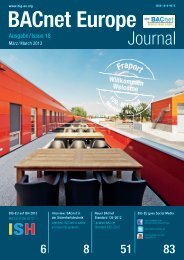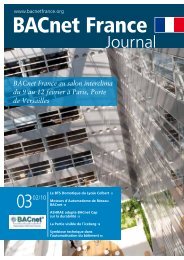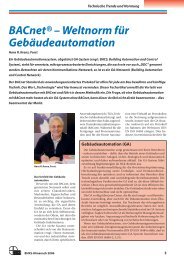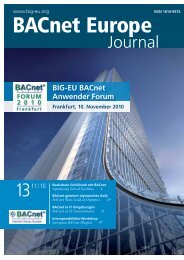BACnet Europe
BACnet Europe
BACnet Europe
You also want an ePaper? Increase the reach of your titles
YUMPU automatically turns print PDFs into web optimized ePapers that Google loves.
EinAlphabetistnichtgenug<br />
Onealphabetisnotenough<br />
LiebeLeserinnenundLeser,<br />
Ein ISO-Standard in der Gebäudeautomation hat viele Facetten und<br />
Perspektiven: Da sind zuerst die technischen Merkmale, die – angepasst<br />
an die Anforderungen eines Gebäudes – dazu beitragen, dass<br />
Lösungen auf Basis des Standards innovativ und zukunftssicher sind.<br />
Zweifelsfrei ist aber auch die kaufmännische Betrachtung wichtig. Denn<br />
nicht nur die Investitionskosten für eine technische Gebäudeausrüstung,<br />
sondern vor allem die Betriebskosten sind ausschlaggebend für die Planung<br />
und Realisierung.<br />
Die Zahl der <strong>BACnet</strong>-Installationen ist seit der Veröffentlichung des<br />
ersten Standards 1995 signifikant gewachsen. Insbesondere im Bereich<br />
der Energieeffizienz entwickeln sich die <strong>BACnet</strong>-Systeme am Markt<br />
immer weiter. Innovative Ideen und Produktlösungen tragen den Anforderungen<br />
nach steigender Kostenreduzierung im Gebäudebetrieb Rechnung.<br />
Da ist es nur konsequent, dass sich auch wesentliche Merkmale<br />
wie die interne Systemkommunikation und die Möglichkeit, über einen<br />
offenen Kommunikationsstandard andere Gewerke einzubinden, mit der<br />
Technik weiter entwickeln.<br />
Mehr denn je ist <strong>BACnet</strong> heute ein innovativer Standard, der sich mit den<br />
Anforderungen des Marktes weiter entwickelt. Eine der bekanntesten<br />
Erweiterungen war Annex j, der <strong>BACnet</strong> IP-konform machte und damit<br />
die Einbindung in bestehende Netze erleichterte. Die Liste der Erweiterungen,<br />
die darauf folgten, ist so lang, dass die einfachen Buchstaben<br />
des Alphabets schon lange nicht mehr ausreichen. Mittlerweile haben<br />
wir die Mitte des Alphabets bereits ein zweites Mal überschritten: Die<br />
jüngsten Erweiterungen vom Frühjahr 2012 tragen deshalb die Bezeichnung<br />
„Annex aq“ (alle zu finden unter: www.bacnet.org / Addenda).<br />
Diese beeindruckende Dynamik zeigt uns einmal mehr, dass der <strong>BACnet</strong><br />
Standard konsequent vorangetrieben und gepflegt wird.<br />
Wie der Standard hat sich auch unser <strong>BACnet</strong> Journal weiter entwickelt.<br />
Es erscheint mit dieser Ausgabe erstmals in neuem Layout und mit<br />
aktuellen Inhalten. Ich freue mich, dass immer mehr Mitglieder das Heft<br />
zum Informationsaustausch nutzen und zu dessen Gelingen beitragen.<br />
DearReader,<br />
VorwortPreface<br />
An ISO standard for building automation has many facets and perspectives:<br />
Firstly, there are technical features that are adapted to<br />
the requirements of a building and contribute to standards-based solutions<br />
that are innovative and futuristic. Undoubtedly, the commercial<br />
view is important, not only for the investment cost of technical building<br />
equipment, but also the operating costs, which are critical to planning<br />
and implementation.<br />
The number of <strong>BACnet</strong> installations, since the publication of the first<br />
standards in 1995, has grown significantly. The <strong>BACnet</strong> system continues<br />
to develop in the market, particularly in the area of energy<br />
efficiency. Innovative ideas and product solutions grow to meet the<br />
requirements for greater cost reductions in building operating calculations.<br />
Consequently, it is only logical to develop other disciplines with<br />
the technology for essential features such as the internal communication<br />
system and the possibility to integrate other facilities with an open<br />
communication standard.<br />
More than ever, <strong>BACnet</strong> is today an innovative standard that develops<br />
with the needs of the market. One of the most popular extensions was<br />
addendum j, which made <strong>BACnet</strong> IP compliant and facilitates integration<br />
into existing networks. The list of add-ons that followed was so<br />
long that there were not enough letters in the alphabet to describe<br />
it. In the meantime, we have exceeded the middle of the alphabet<br />
for a second time: The most recent addition made in spring of 2012<br />
therefore is entitled “Addendum aq” (all addenda can be found here:<br />
www.bacnet.org / Addenda). This impressive dynamic shows us once<br />
again that the <strong>BACnet</strong> standard is consistently pursued and maintained.<br />
As the standard developed, so too did our <strong>BACnet</strong> Journal. For the first<br />
time, in this issue, a new layout and newsworthy content are being<br />
debuted. I am glad that more and more members use the Journal to<br />
share information and contribute to its success.<br />
Volker Röhl<br />
Präsident der BIG-EU<br />
President of the BIG-EU<br />
STRABAG-PFS<br />
<strong>BACnet</strong> <strong>Europe</strong> Journal1710/12 3
















